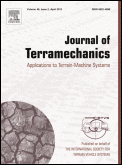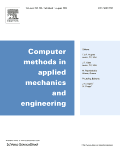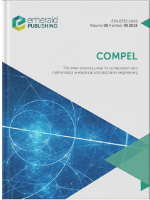
JOURNAL OF TERRAMECHANICS
Scope & Guideline
Pioneering Research in Mechanical Engineering
Introduction
Aims and Scopes
- Vehicle-Terrain Interaction:
The journal emphasizes studies on how different vehicles interact with various types of terrain, including soft soils, granular media, and extraterrestrial surfaces. This includes analyses of traction, drag, and overall mobility. - Modeling and Simulation Techniques:
A core focus of the journal is the development and application of advanced modeling techniques, such as discrete element methods (DEM), finite element methods (FEM), and machine learning approaches, to simulate and predict vehicle performance on diverse terrains. - Innovative Vehicle Design:
Research published in the journal often involves the design and optimization of vehicles and their components, including wheels, tracks, and propulsion systems, to enhance mobility and efficiency on challenging surfaces. - Experimental Methodologies:
The journal includes experimental investigations that validate theoretical models and simulations, offering insights into real-world performance of vehicles and their interactions with soil. - Emerging Technologies in Terramechanics:
There is a growing interest in incorporating new technologies such as IoT, AI, and UAVs into terramechanics research, highlighting the journal's commitment to innovative applications in agriculture and extraterrestrial exploration.
Trending and Emerging
- Machine Learning Applications:
There is a growing trend in employing machine learning for predicting soil-vehicle interactions, optimizing designs, and enhancing mobility assessments, reflecting the integration of data-driven approaches in terramechanics. - Multi-Physics Modeling:
Research increasingly incorporates multi-physics modeling that combines different physical phenomena (e.g., fluid dynamics, soil mechanics) to provide a more comprehensive understanding of vehicle performance on complex terrains. - Remote Sensing and IoT Integration:
The use of remote sensing technologies and IoT devices for real-time monitoring and assessment of soil conditions and vehicle performance is on the rise, showcasing a shift towards smart agriculture and autonomous systems. - Advanced Terrain Characterization Techniques:
Emerging methodologies for detailed terrain characterization, including the use of UAVs and sophisticated imaging techniques, are becoming more prevalent, facilitating better understanding of soil properties. - Robotic Mobility Studies:
Research focused on the mobility of robotic systems, particularly in extraterrestrial environments, is gaining momentum, highlighting advancements in autonomous navigation and adaptive locomotion.
Declining or Waning
- Traditional Soil Testing Methods:
There is a noticeable reduction in studies focusing solely on conventional soil testing methods, as more researchers are adopting advanced modeling techniques and machine learning approaches to predict soil behavior. - Basic Traction Studies:
While traction remains a key area, the focus on basic traction studies without integration of complex variables such as moisture content, surface roughness, or vehicle dynamics appears to be decreasing. - Static Analysis of Soil Interaction:
Research primarily centered on static interactions between vehicles and soil is becoming less frequent, with a shift towards dynamic modeling that considers real-time changes in terrain and vehicle response. - Conventional Agricultural Machinery Analysis:
Studies that only analyze traditional agricultural machinery without considering innovative designs or technologies are declining, as the field moves towards more advanced and integrated approaches. - Generalized Mobility Models:
There seems to be a waning interest in generalized models that do not account for specific terrains or vehicle types, as researchers are increasingly focusing on tailored models that address unique challenges.
Similar Journals

Journal of the Serbian Society for Computational Mechanics
Fostering Collaboration in Computational ResearchJournal of the Serbian Society for Computational Mechanics, published by the Serbian Society for Computational Mechanics, is a vital platform for advancing research and knowledge in the field of computational mechanics. Established in 2012, this journal serves the academic community by providing a forum for innovative studies, methodologies, and applications within computational mechanics, presenting valuable insights for researchers, professionals, and students alike. With an ISSN of 1820-6530 and a ranking of Q4 in Computational Mechanics, it carries an essential influence in the engineering realm, despite its current rank of 71 out of 89. The journal's commitment to scholarly excellence aims to foster collaboration and encourage interdisciplinary research, making it an important resource for those invested in the evolving landscape of computational methodologies. Although the journal currently does not offer Open Access options, it remains dedicated to disseminating knowledge that will resonate within the local and global scientific community.

INTERNATIONAL JOURNAL OF FRACTURE
Unveiling Breakthroughs in Computational MechanicsInternational Journal of Fracture, published by Springer, stands as a leading peer-reviewed platform dedicated to advancing the field of fracture mechanics and its applications. Since its inception in 1973, this journal has provided a crucial forum for innovative research and discussions, addressing pivotal topics in computational mechanics, mechanics of materials, and modeling and simulation. With a significant impact factor and a Q1 classification in computational mechanics, it ranks impressively within the Scopus metrics, further solidifying its relevance among global researchers and professionals. The journal caters to an international audience by fostering the exchange of knowledge and cutting-edge discoveries, making it an essential resource for those engaged in the latest advancements and applications in material fracture studies. Its commitment to high-quality research ensures that the findings published within its pages not only contribute to academic discourse but also influence real-world engineering and manufacturing practices.

COMPUTER METHODS IN APPLIED MECHANICS AND ENGINEERING
Leading the Charge in Computational Mechanics Excellence.COMPUTER METHODS IN APPLIED MECHANICS AND ENGINEERING, published by Elsevier Science SA, is a premier journal that has significantly contributed to the fields of computational mechanics, computer science applications, mechanical engineering, and the mechanics of materials since its inception in 1972. With an ISSN of 0045-7825 and an E-ISSN of 1879-2138, this journal is recognized for its rigorous peer-review process and is consistently ranked in the Q1 quartile across multiple categories, including Computational Mechanics and Mechanical Engineering. Its impressive Scopus rankings place it in the top tiers of its field, with a percentile ranking of 98th in Computational Mechanics. Researchers, professionals, and students will find the journal's comprehensive scope and high-quality articles invaluable for advancing their knowledge and practices at the intersection of engineering and computation. Although not an open-access journal, its impactful contributions to both theoretical and applied research make it an essential resource for anyone involved in these dynamic fields.

Computational Particle Mechanics
Transforming Knowledge into Cutting-Edge ApplicationsComputational Particle Mechanics, published by SPRINGER INTERNATIONAL PUBLISHING AG, is a leading journal dedicated to advancing knowledge in the interdisciplinary fields of computational mechanics, civil engineering, and fluid dynamics. With an impressive impact factor reflecting its high-quality research publications, this journal maintains a strong presence in the academic community with a Q1 ranking in categories such as Civil and Structural Engineering, Computational Mechanics, and Numerical Analysis as per the latest 2023 evaluations. Researchers and professionals benefit from the journal's commitment to open-access options, promoting wider dissemination of groundbreaking studies. Operating under the Swiss publishing house since 2014, Computational Particle Mechanics aims to foster innovation through the exploration of particle-based methods and simulations, making significant contributions to methodologies within computational mathematics and modeling. As the journal continues to evolve until its converged years end in 2024, it stands as a vital resource for those looking to enhance their expertise in dynamic modeling and simulation techniques.

Vehicles
Connecting Researchers to Drive Vehicle InnovationVehicles is a pioneering open access journal published by MDPI since 2019, dedicated to advancing knowledge in the fields of Automotive Engineering and Electrical and Electronic Engineering. Based in Switzerland, the journal provides a valuable platform for researchers, professionals, and students to disseminate high-quality, peer-reviewed research across essential areas of vehicle technology and innovation. With an impressive Q2 ranking in both Automotive Engineering and Electrical and Electronic Engineering as of 2023, and a notable placement in the Scopus rankings (Rank #37/125 and #320/797, respectively), Vehicles plays a critical role in fostering collaboration and knowledge exchange within these fast-evolving disciplines. Through its commitment to Open Access, Vehicles ensures that cutting-edge research is accessible to a global audience, thereby contributing significantly to the collective understanding and development of sustainable transportation solutions. Situated at the crossroads of engineering innovation and practical application, Vehicles invites contributions that explore contemporary challenges and promote transformative advancements in the automotive sector.

Izvestiya of Saratov University Mathematics Mechanics Informatics
Unveiling New Perspectives in Mathematical and Mechanical SciencesIzvestiya of Saratov University Mathematics Mechanics Informatics is a prominent open access journal published by Saratov State University, focusing on the interdisciplinary fields of mathematics, mechanics, and computer science. Established as an accessible platform for researchers since 2007, this journal fosters the dissemination of innovative research and advancements in computational mechanics, general mathematics, and mechanical engineering among others. Although currently categorized within the Q4 quartile rankings in various domains, including Computational Mechanics and Mechanics of Materials, it serves as a crucial resource for professionals and scholars aiming to explore emerging trends and methodologies. Operating out of Saratov, Russian Federation, this journal not only contributes to local academic discourse but also holds international relevance, welcoming submissions that push the boundaries of traditional research. Researchers, professionals, and students alike are encouraged to engage with the wealth of knowledge presented within its pages, reinforcing the journal’s role as a vital component in the ongoing development of these scientific fields.

APPLIED MATHEMATICAL MODELLING
Advancing Real-World Solutions Through Mathematical InnovationApplied Mathematical Modelling is a premier journal published by Elsevier Science Inc, dedicated to advancing the field of applied mathematics through the dissemination of high-quality research. With an impressive Impact Factor that places it in the Q1 category for both Applied Mathematics and Modeling and Simulation, this journal has established itself as a critical resource for researchers and practitioners alike, boasting a Scopus rank of #17 out of 635 in Applied Mathematics and #15 out of 324 in Modeling and Simulation. Since its inception in 1976, it has provided a vital platform for innovative models and techniques that drive progress across various scientific disciplines. Researchers will find an extensive range of articles addressing contemporary issues and developments, making it an essential read for anyone interested in the application of mathematical frameworks to real-world problems. While the journal maintains a subscription-only access model, its impactful contributions ensure that it remains an influential voice in the landscape of applied mathematics.

COMPEL-THE INTERNATIONAL JOURNAL FOR COMPUTATION AND MATHEMATICS IN ELECTRICAL AND ELECTRONIC ENGINEERING
Empowering Research in Electrical and Electronic MathematicsCOMPEL - THE INTERNATIONAL JOURNAL FOR COMPUTATION AND MATHEMATICS IN ELECTRICAL AND ELECTRONIC ENGINEERING is a leading peer-reviewed journal published by Emerald Group Publishing Ltd, dedicated to advancing the fields of computation and mathematical applications in electrical and electronic engineering. Since its inception in 1982, the journal has been a pivotal resource for researchers, professionals, and students alike, promoting innovative methodologies and contributing to the knowledge base within its scope. With a current impact factor reflecting its growing influence, COMPEL offers valuable insights across several quartile categories, allowing contributors to engage with important advancements in applied mathematics and computational theory. Although it operates under a subscription model, the journal ensures that accessible and impactful research reaches a wide audience. As it continues to converge towards its milestone in 2024, COMPEL remains an essential platform for those seeking to explore the interplay between complex computational challenges and engineering solutions.

Communications in Transportation Research
Leading the way in transportation decision sciences.Communications in Transportation Research is a premier open access journal published by ELSEVIER, dedicated to advancing the understanding of transportation systems and their integration within the broader contexts of engineering, decision sciences, and social sciences. Launched in 2021, this journal has quickly established itself as a leading platform for innovative research, achieving impressive rankings in its categories, including Q1 status in Control and Systems Engineering, Decision Sciences, and Transportation. With its comprehensive scope, covering areas from fundamental engineering principles to applied decision-making processes, the journal attracts a diverse audience of researchers, professionals, and students eager to contribute to and learn from cutting-edge studies that shape the future of transportation. The journal’s commitment to open access ensures that valuable insights and data are freely available, fostering collaboration and knowledge sharing across the global research community.

Geotechnique Letters
Fostering Excellence in Geotechnical Research.Geotechnique Letters is a prestigious journal published by Emerald Group Publishing Ltd, with a focused dedication to advancing the field of geotechnical engineering and engineering geology. Since its inception in 2011, the journal has rapidly established itself as a leading platform for disseminating high-quality research and innovative practices, earning a stellar Q1 ranking in both Earth and Planetary Sciences (miscellaneous) and Geotechnical Engineering categories as of 2023. With an ISSN of 2049-825X and E-ISSN 2045-2543, this journal captures vital insights and cutting-edge developments that cater to researchers, industry professionals, and students passionate about geotechnical challenges. Although it operates under a subscription model, the journal offers options for authors to publish their work—enhancing accessibility for those seeking to share knowledge within the community. The Scopus rankings place it comfortably within the top echelons of its field, affirming its importance and influence in shaping the future of geotechnical research and practice. With converged years extending to 2024, Geotechnique Letters is positioned as an essential resource for anyone looking to stay atop advancements and discussions in geotechnical sciences.